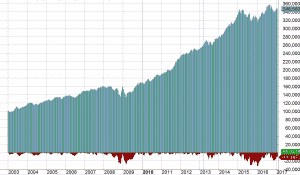 Tactical Asset Allocation – What is it and how do I benefit?
Tactical Asset Allocation – What is it and how do I benefit?
Before we dive into the tactical asset allocation (TAA), lets look first into what asset allocation overall is: By asset allocation we understand the strategy and investor follows to decide how to distribute their investments among the different asset classes that exist. That is, it is the process by which you decide how much money goes to fixed income, variable income, real estate assets, industrial sectors, countries . The objective of asset allocation and portfolio management is basically to balance the risk and return of a portfolio in the best possible way .
This distribution of the investment normally depends on two main factors. On the one hand, the risk tolerance or risk aversion profile of the investor and, on the other, the economic situation of the moment.
There are many asset classes to direct the investment, although most investors are limited to a few. The most commonly used are: variable income, fixed income, currencies, raw materials or real estate.
The process of asset allocation consists of three phases:
- The Selection of assets: Choose the broad asset class in which to invest and if needed also the break down of the asset classes, for example, which markets to choose within variable income.
- Combine these assets in a way that suits our objectives and takes into account our limitations as investors. We must especially consider the investment horizon and the risk we are willing to assume.
- Manage the combination of your asset allocation over time. That is, address the situation that each asset lives at a particular time to decide whether we have to raise or lower the percentage we have invested in them.
Strategic versus tactical asset allocation
Tactical asset allocation models differ from strategic asset allocation by that the former are dynamic on the time horizon. Strategic asset allocation normally establishes a long term fixed allocation into the different assets, sometimes with bands these are allowedo to fluctuate within. The asset manager will only rebalance the allocation when a particular asset class moves out of this band, or when established critera call for a change – typically established and monitored by an investment committee overseeing market conditions.
In contrast, tactical asset allocation uses modeled portfolio which change regularly – and normally at fixed intervals – the mix and weightings of asset classes to be hold. The rules for these changes are estalished by mathematical models, translated into an algoritm which monitors certain parameters and creates new allocations based on these changes.
Tactical asset allocation – Clear rules for implementation and monitoring
In tactical asset allocation we define a clear set of rules. These rules comprise an investment strategy. Here is an example strategy:
“At the first day of the month, look at the performance of bonds versus stocks by calulating the 3-month performances of two exchange traded funds, SPY (the SPDR S&P 500 ETF) and TLT (the iShares 20+ Year Treasury Bond ETF). If SPY outperforms, then re-balance the portfolio to 60% SPY, 40% TLT. If not, rebalance to 40% SPY, 60% TLT.”
Investing: Why follow tactical asset allocation models? It eliminates our main weakness, emotion.

Developed through years of evolution, our basic human instincts are necessary for our survival. Keeping with the laws of the jungle, these instincts push us to run when in danger and charge when we see opportunity. The stock market, much like a casino, is built to take advantage of these instincts. Investors, if left to their primitive fear/greed instincts, tend to buy high and sell low.![]()
These instincts harm our investing decisions. They make a naive person wait for a stock to double, triple, quadruple until every single person he knows claims to have made huge profits. Then he decides to buy, only to see the stock crash! What happens next to our hypothetical investor, is he looks at a-10% loss and hopes it will rebound. At -20% he starts getting worried, At -27% he thinks of selling but, hey, this may be the bottom, since he want to sell, right? At -40% he goes into shock and stops looking at the stock. At -60%, he gives up and stops checking his account. He feels he has been cheated and exits the markets. It may take years for him to return, if at all.
Following rules and modeled portfolio established by tactical asset allocation models, eliminates this process. When the investment strategy dictates for a buy, we buy. When it triggers a sell, we sell. There is still an element of emotion involved but it operates at a secondary level. Is my model correct? Do I trust the model. This, too can be minimized, by backtesting, as we will see later.
Tactical asset allocation eliminates the Ego (and opinion).
Talking about trading sometimes resembles a teenage boy’s conversation. “I bought this stock when it was $2 and now it is at $200!” “I made $10000 last month”. “I bought an option and made 10x in a week!”. We hear stories like that and assume that they are important. If someone invests $200 and makes $20,000, good for them! But one cannot live off $20,000. That person is not telling you what they may be doing with the rest of their savings, some $500,000 parked at 0% cash. This game is not about how smart you are.
Strong opinions, like the ego may also hinder an investor. This is especially true as we get older and feel wiser. A perfectly logical opinion goes like this: “It is 2011 and interest rates are almost zero. In my opinion interest will rise in the future“( What else can they do?). Thus I will short Treasuries!”
Six years later, that investor may have lost 30% and still stick to his opinion.
Following rules eliminates ego and eliminates opinion. If the investment strategy is programmed to pick up assets that are trending upwards, it will buy treasuries in 2011 whatever you believe. If gold trends downward for years the strategy may drop it, whether you believe in gold or not. Nervelessness there are still biases at play, even when following a strategy. How smart is my strategy? How smart am I for picking this strategy? And so on… But these are easier to deal with. At the end of the day the question should not be, how smart am I but rather how disciplined am I.
Tactical asset allocation models help you survive.
History shows that if you invest in an index and stay in the market for 20+ years, you will probably make money. The challenge is to stick around. The more you get involved emotionally in the market, the quicker you will tire and give up. By following a rules-based strategy, you can spend less time watching the markets, reading news and analyses and spend more time doing things you enjoy. In the process you will also improve your health!
Because in investing, as in life, your most valued asset is time. The more you have the better your chances are.
How to get started with a tactical asset allocation model?
A tactical asset allocation strategy normally invest into ETF, index funds or mutual funds which can easily be trades by the average investor. These instruments ensure low transaction cost and high liquidity, which can be especially critical in bear markets when everybody runs to the exit. These asset allocation ETF or other funds normally hold a broad range of equities like large cap or small cap stocks, developed or emerging markets, commodities, real estate, fixed income like treasury or corporate bonds.
Over the last years we have created tactical asset allocation models which cover most styles and investment types. See our individual asset allocation models and investment portfolios constructed by combining different models into a broader and diversified basket of styles, instruments and underlying instruments. You can test all our offering for free during one month after registering, and even therafter continue to use our free lazy portfolio and other asset allocation models.
If you prefer to create your own tactical asset allocation model you can do so with our QuantTrader backtesting software, a free one month trial is available upon registration.